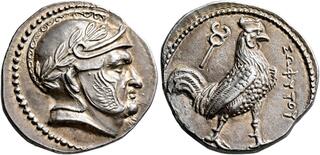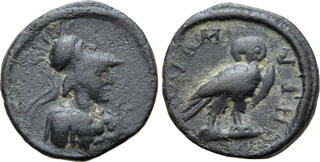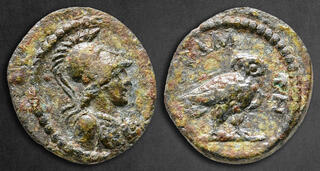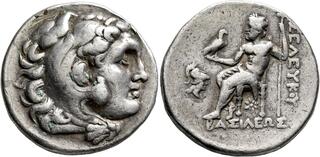Match 1:
Match 2:
Match 3:
Match 4:
| Leu Numismatik AG > Auction 15 | Auction date: 1 June 2024 |
| Lot number: 176 Price realized: This lot is for sale in an upcoming auction - Bid on this lot  | |
| Lot description: BAKTRIA, Local Issues. Sophytos, circa 270s or 240s-230s BC. Didrachm (Silver, 22 mm, 7.87 g, 6 h), Attic standard, uncertain mint in the Oxus region. Male head to right, wearing laureate and crested Attic helmet, cheek guards lowered and decorated with wings; on neck truncation, M. Rev. ΣΩΦYΤΟΥ Rooster standing right; above, kerykeion. Bopearachchi, Sophytes 3A and pl. I, 2. HGC 12, -. Jansari - (O1/-). MGI -. SNG ANS -. Very rare. A spectacular example of this intriguing issue, with a superb portrait of the finest early Hellenistic style and a wonderful reverse. Good extremely fine. Ex Roma XXV, 22 September 2022, 540. There has been extensive discourse regarding the identity and precise dating of Sophytos, an enigmatic Baktrian ruler of uncertain origin who minted a series of magnificent silver coins during the 3rd century BC. First published in 1866 by Sir Alexander Cunningham (1814-1893), Sophytos' coinage exhibits a remarkable fusion of various Greek motifs alongside a distinctly non-Greek name. Cunningham connected the Sophytos from the coins with the Indian ruler Sophytes, who subjected to Alexander in 326 in the Punjab. However, the coins are clearly not from the Punjab, and their iconography also suggests a later period. Indeed, scholars have long noted that the striking helmeted male heads on the obverse are linked to Seleukos' eastern victory series, featuring a helmeted and horned head on the obverse and Nike erecting a trophy on the reverse. Consequently, S. Jansari recently proposed viewing the coins of Seleukos and Sophytos as roughly contemporary, thereby dating the latter's reign to circa 305/4-295 (S. Jansari: Two Sides of the Coin, in: R. Mairs (ed.): The Graeco-Bactrian and Indo-Greek World. London & New York 2021, pp. 487-498). However, Jansari later also suggests dating Sophytos to circa 315-305, implying that his coinage influenced that of Seleukos, rather than the reverse. The latter, especially, is so improbable to the extent that it warrants no consideration here, as it suggests that Sophytos placed his own name on his coins prior to any of the Diadochi. Sophytos' coinage is deeply routed in the iconography of the early Hellenistic era, and it seems much more likely that he followed Greek precursors than the other way around. Indeed, the reverse type on our wonderful didrachm appears to have been directly borrowed from the early Hellenistic coinage of Karystos on Euboia, down to the precise placement of the symbol and legend (see f.e. BCD 572). Jansari rightfully notes that the rooster, the kerykeion, and the wing on the cheek guard all allude to the Greek god Hermes. Additionally, the controls M, MN, and MNA found on Sophytos' coinage are also present on a series of Baktrian imitations of Athenian owls. Notably, Sophytos himself issued an exceedingly rare series featuring owls on the reverse, rendering his coinage less isolated than one might think. The dating of Sophytos' reign remains a subject of debate. There are currently two schools of thought, one aligns Sophytos with the early years of Antiochos I's reign, around the 270s BC, while the other associates him with the usurper Andragoras in Parthia, placing his rule in the 240s and early 230s BC. The former emphasizes Sophytos' connection to the coinage of Seleukos, tracing his issues back to the local Baktrian owl coinage of the 290s and 280s BC. The latter view leans on reported findings that place Sophytos' coins alongside those of Andragoras. Both theories present their strengths and challenges, and it remains premature to determine which will ultimately prevail. Despite being overlooked by Graeco-Roman historiography, we know little about him beyond his evident position of power and his ability to command both resources and skilled artists to produce a most impressive Greek coinage of the finest style. Interestingly, his name, while non-Greek in origin, is not 'Sophytes', as is commonly assumed, as 'Sophytou' is the genitive of 'Sophytos', not 'Sophytes'. This distinction is reinforced by the appearance of the same name, in the nominative case, in the renowned Kandahar inscription. Here, a Sophytos, son of Naratos (or Narates), recounts his life story in erudite Greek in the 2nd century BC. While it has been suggested that this Sophytos might be a descendant of the early Hellenistic ruler, we simply don't know how common the name was amongst the local population, rendering such speculation akin to presuming any English woman named Elizabeth to be a descendant of Queen Elizabeth II. Estimate: 7500 CHF |  |
Match 5:








